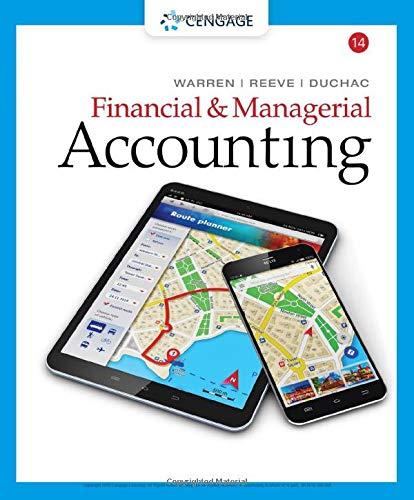Answered step by step
Verified Expert Solution
Question
1 Approved Answer
Please fix the errors below, thanks. Question 1 Question 2 Seminole Company began the year with 25,500 units of product in its January 1 inventory
Please fix the errors below, thanks.
Question 1


Question 2



Seminole Company began the year with 25,500 units of product in its January 1 inventory costing $16.10 each. It made purchases of its product during the year as follows. The company uses a periodic inventory system. On December 31, a physical count reveals that 46,000 units of its product remain in inventory. Mar. 7 39,000 units @ $19.10 each May 25 41,000 units @ $23.10 each Aug. 1 31,000 units @ $25.10 each Nov. 10 38,500 units @ $28.10 each Required: 1. Compute the number and total cost of the units available for sale during the year. 2. Compute the amounts assigned to ending inventory and the cost of goods sold using (a) FIFO, (b) LIFO, and (c) weighted average. Complete this question by entering your answers in the tabs below. Required 1 Required 2 Compute the number and total cost of the units available for sale during the year. units Total units available for sale Total cost of units available for sale 175,000 $ 3,962,500 Required 1 Required 2 > Seminole Company began the year with 25,500 units of product in its January 1 inventory costing $16.10 each. It made purchases of its product during the year as follows. The company uses a periodic inventory system. On December 31, a physical count reveals that 46,000 units of its product remain in inventory. Mar. 7 39,000 units @ $19.10 each May 25 41,000 units @ $23.10 each Aug. 1 31,000 units @ $25.10 each Nov. 10 38,500 units @ $28.10 each Required: 1. Compute the number and total cost of the units available for sale during the year. 2. Compute the amounts assigned to ending inventory and the cost of goods sold using (a) FIFO, (b) LIFO, and (c) weighted average. Complete this question by entering your answers in the tabs below. Required 1 Required 2 Compute the amounts assigned to ending inventory and the cost of goods sold using (a) FIFO, (b) LIFO, and (c) weighted average. (Do not round intermediate calculations. Round the final answers to nearest whole dollars.) (b) LIFO Periodic (a) FIFO Periodic $ 3,962,500 1,270,100 $ 2,692,400 Total cost of units available for sale Less ending inventory Cost of units sold $ (c) Weighted Average Periodic 3,962,500 1,041,440 2,921,060 $ 3,962,500 802,100 $ 3,160,400 $ A machine costing $208,000 with a four-year life and an estimated $16,000 salvage value is installed in Luther Company's factory on January 1. The factory manager estimates the machine will produce 480,000 units of product during its life. It actually produces the following units: 122,900 in Year 1, 124,200 in Year 2, 121,200 in Year 3, 121,700 in Year 4. The total number of units produced by the end of Year 4 exceeds the original estimatethis difference was not predicted. (The machine cannot be depreciated below its estimated salvage value.) Required: Compute depreciation for each year (and total depreciation of all years combined) for the machine under each depreciation method. (Round your per unit depreciation to 2 decimal places. Round your answers to the nearest whole dollar.) Complete this question by entering your answers in the tabs below. Straight Line Units of Production DDB Compute depreciation for each year (and total depreciation of all years combined) for the machine under the Units of production. Year Units 1 Units of Production Depreciable Depreciation Units per unit 122,900 $ 0.40 124,200 $ 0.40 121,200 $ 0.40 111,700 $ 0.40 $ 480,000 122,900 124,200 121,200 121,700 2 Depreciation Expense $ 49,160 49,680 48,480 44,680 $ 192,000 3 4 Total A machine costing $208,000 with a four-year life and an estimated $16,000 salvage value is installed in Luther Company's factory on January 1. The factory manager estimates the machine will produce 480,000 units of product during its life. It actually produces the following units: 122,900 in Year 1, 124,200 in Year 2, 121,200 in Year 3, 121,700 in Year 4. The total number of units produced by the end of Year 4 exceeds the original estimatethis difference was not predicted. (The machine cannot be depreciated below its estimated salvage value.) Required: Compute depreciation for each year (and total depreciation of all years combined) for the machine under each depreciation method. (Round your per unit depreciation to 2 decimal places. Round your answers to the nearest whole dollar.) Complete this question by entering your answers in the tabs below. Straight Line Units of Production DDB Compute depreciation for each year (and total depreciation of all years combined) for the machine under the Double- declining-balance. End of Period Year Accumulated Depreciation Book Value 1 DDB Depreciation for the Period Beginning of Period Depreciation Depreciation Book Rate Expense Value $ 208,000 50 % $ 104,000 104,000 50 % 52,000 52,000 50 % 26,000 26,000 50 % 13,000 $ 195,000 $ N 104,000 156,000 182,000 195,000 $ 104,000 52,000 26,000 13,000 3 4 Total
Step by Step Solution
There are 3 Steps involved in it
Step: 1

Get Instant Access with AI-Powered Solutions
See step-by-step solutions with expert insights and AI powered tools for academic success
Step: 2

Step: 3

Ace Your Homework with AI
Get the answers you need in no time with our AI-driven, step-by-step assistance
Get Started


